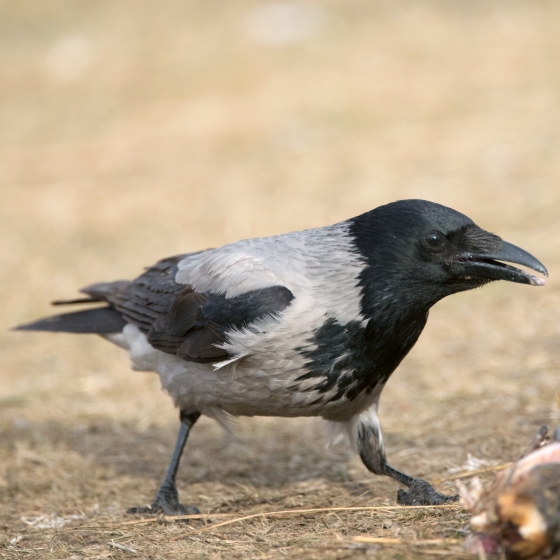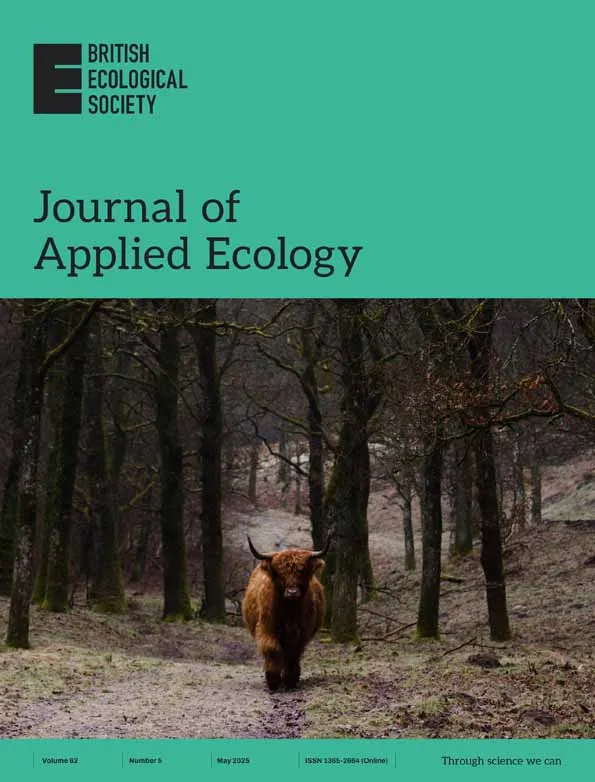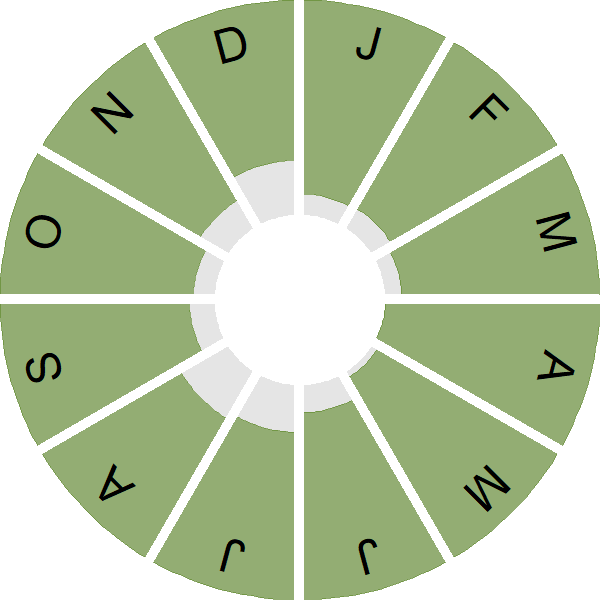Hooded Crow

Introduction
The two tone corvid, the Hooded Crow or 'hoodie' was classified by the British Ornithologists' Union as a distinct species in 2002.
The Hooded Crow is found in the north and north-west of the UK, where it is far more numerous than Carrion Crow. Where ranges of the two overlap, the crows can hybridise and produce offspring resembling a dark, less contrasting Hooded Crow.
This resident species breeds relatively early, from March laying up to six eggs are laid in large twiggy nests lined with wool and/or hair, typically located in trees, crags or pylons. The population trend for the UK is stable, although this is underpinned by recent declines in the Scotland and increases in Northern Ireland.
- Our Trends Explorer gives you the latest insight into how this species' population is changing.

Key Stats
Identification
Songs and Calls
Call:
Flight call:
Young call:
Status and Trends
Conservation Status
Population Change
The BOU Records Committee took the decision in 2002 to treat Hooded Crow and Carrion Crow as separate species (Parkin et al. 2003). This split is not recognised in BirdLife International's conservation listings. In the UK, Hooded Crows occur in Northern Ireland, the Isle of Man, and in Scotland, mainly west and north of the Great Glen. Retrospective analysis of BBS trends is simple because observers have always recorded Hooded Crows (coded HC) separately from Carrion Crows and from intermediates (coded HB). Intermediate forms between Carrion and Hooded, which predominate in a band across western Scotland and occur less frequently elsewhere in the UK, are not included in either species' BBS index. BBS data suggest that moderate decrease in Hooded Crows has occurred in Scotland, but that this has been countered by a steep increase in Northern Ireland. Hooded Crows had increased markedly in Ireland since 1924 (Hutchinson 1989). The 2007-11 Atlas records little change in the distribution of Hooded Crows but show further incursion of Carrion Crows into northwest Scotland and eastern Ireland (Balmer et al. 2013). There has been an increase among Hooded and Carrion Crows, taken together, across Europe since 1980 (PECBMS: PECBMS 2020a>).
Distribution
Hooded Crows replaces Carrion Crows in Ireland and most of north and west Scotland. In the eastern part of their Scottish range, Hooded Crows overlap with the Carrion Crows and hybrids are common in a narrow hybrid zone which had been shifting north and west as Carrion Crows gained ground in the lowlands.
Occupied 10-km squares in UK
2007/08–10/11
or view it on Bird Atlas Mapstore.
2008–11
or view it on Bird Atlas Mapstore.
European Distribution Map
Distribution Change
Change in occupied 10-km squares in the UK
from 1981–84 to 2007–11
or view it on Bird Atlas Mapstore.
from 1968–72 to 2008–11
or view it on Bird Atlas Mapstore.
Seasonality
Hooded Crow is recorded throughout the year.
Weekly pattern of occurrence
The graph shows when the species is present in the UK, with taller bars indicating a higher likelihood of encountering the species in appropriate regions and habitats.

Habitats
Breeding season habitats
Relative frequency by habitat
The graph shows the habitats occupied in the breeding season, with the most utilised habitats shown at the top. Bars of similar size indicate the species is equally likely to be recorded in those habitats.

Movement
Britain & Ireland movement
Foreign locations of birds ringed or recovered in Britain & Ireland
Dots show the foreign destinations of birds ringed in Britain & Ireland, and the origins of birds ringed overseas that were subsequently recaptured, resighted or found dead in Britain & Ireland. Dot colours indicate the time of year that the species was present at the location.
- Winter (Nov-Feb)
- Spring (Mar-Apr)
- Summer (May-Jul)
- Autumn (Aug-Oct)

European movements
EuroBirdPortal uses birdwatcher's records, such as those logged in BirdTrack to map the flows of birds as they arrive and depart Europe. See maps for this species here.
The Eurasian-African Migration Atlas shows movements of individual birds ringed or recovered in Europe. See maps for this species here.
Biology
Productivity and Nesting
Nesting timing
Egg measurements
Clutch Size
Survival and Longevity
Survival is shown as the proportion of birds surviving from one year to the next and is derived from bird ringing data. It can also be used to estimate how long birds typically live.
View number ringed each year in the Online Ringing Report.
Lifespan
Biometrics
Wing length and body weights are from live birds (source).
Ring Size
Classification, names and codes
Classification and Codes
- Order: Passeriformes
- Family: Corvidae
- Scientific name: Corvus cornix
- Authority: Linnaeus, 1758
- BTO 2-letter code: HC
- BTO 5-letter code: HOOCR
- Euring code number: 15673
Alternate species names
- Catalan: cornella emmantellada
- Czech: vrána šedá
- Danish: Gråkrage
- Dutch: Bonte Kraai
- Estonian: hallvares
- French: Corneille mantelée
- Gaelic: Starrag
- German: Nebelkrähe
- Hungarian: dolmányos varjú
- Icelandic: Grákráka
- Irish: Caróg Liath/Caróg Dhubh
- Italian: Cornacchia grigia
- Latvian: peleka varna
- Lithuanian: pilkoji varna
- Norwegian: Kråke
- Polish: wrona (zwyczajna)
- Portuguese: gralha-cinzenta
- Slovak: vrana popolavá
- Slovenian: siva vrana
- Spanish: Corneja Cenicienta
- Swedish: gråkråka
- Welsh: Brân Lwyd
Research
Causes of Change and Solutions
Causes of change
There is little good evidence available regarding the drivers of the breeding population change in this species in the UK.
Further information on causes of change
No further information is available.
Information about conservation actions
Numbers are stable or increasing, hence the Hooded Crow is not a species of concern and no conservation actions are currently required.
As is the case with Carrion Crow, Hooded Crows have been blamed for the declines of other species such as songbirds and waders, leading to calls to control numbers, and legal control of crows still occurs on shooting estates.
Publications (1)
Associations between gamebird releases and general predators
Author: Pringle, H., Wilson, M., Calladine, J. & Siriwardena, G.M.
Published: 2019
BTO research reveals that the release of Pheasants and Red-legged Partridges for commercial shoots may be boosting numbers of the avian predators and scavengers. Every year, 41-50 million non-native gamebirds (Pheasant and Red-legged Partridge) are released in the UK. Fewer than half these birds are shot, meaning there is potentially a large food resource available to predators and scavengers, sustaining their populations above the levels they would otherwise reach. If it occurs, this inflation of predator numbers might alter predator-prey dynamics, increasing predation pressure on some vulnerable species, including declining breeding waders like Curlew. This study used data from the Breeding Bird Survey and Bird Atlas 2007-11 to identify associations between the occurrence patterns of gamebirds and the abundance and population growth rates of several generalist predators, including Buzzard, Jay, Raven, Magpie and crows (Carrion and Hooded combined). While many other factors influence predator abundance, such as fine-scale habitat variation, availability of other food sources, and game management activities, the results suggest that large-scale variation in avian predator populations is predominantly positively affected by gamebird releases. The potential implications of this finding need to be thoroughly tested. Such tests could include regulation of releases on a trial basis, to determine effects on ground nesting birds, for example. The compulsory recording of releases and the number of predators controlled would also be valuable for a better understanding of the impacts, positive or negative, of gamebird releases on the wider environment. Read a blog post by publication author Henrietta Pringle discussing the work behind this paper.
02.07.19
Papers

More Evidence
More evidence from Conservation Evidence.com
Partners
Citing BirdFacts
If you wish to cite particular content in this page (e.g. a specific value) it is best to use the original sources as linked in the page. For a more general citation of the whole page please use: BTO (20XX) BirdFacts Species: profiles of birds occurring in the United Kingdom. BTO, Thetford (www.bto.org/birdfacts, accessed on xx/xx/xxxx).

